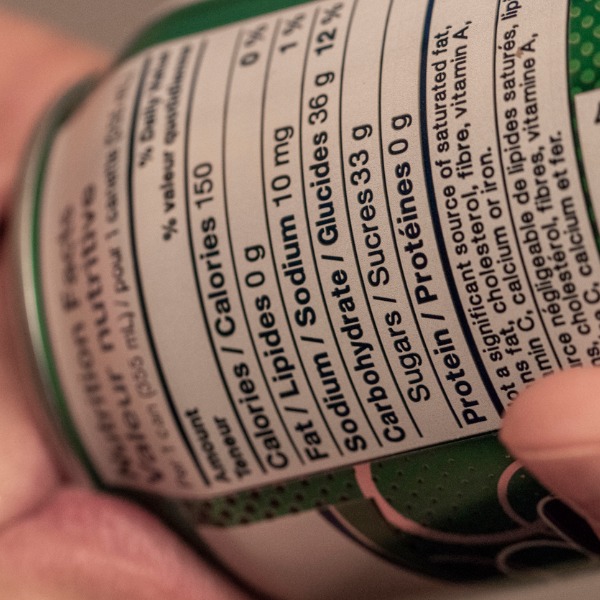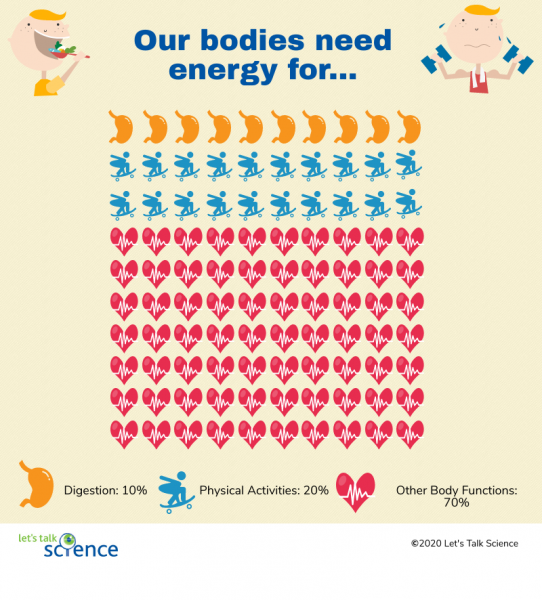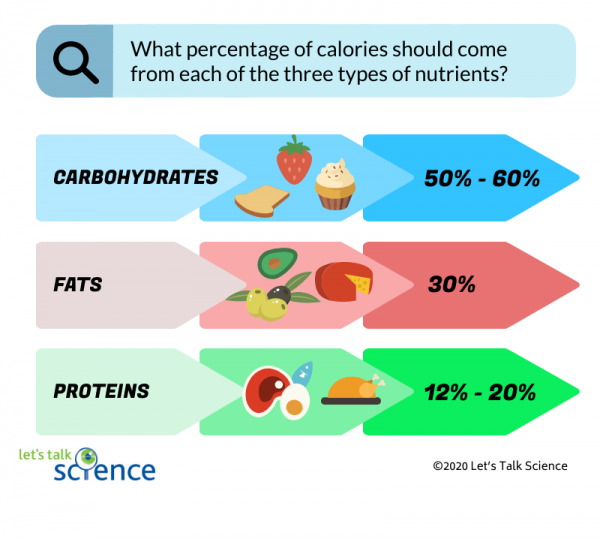The Science Behind Calories and Nutrition Facts Labels

Nutrition label on the side of a pop can (Stephan Malloch, iStockphoto)

Nutrition label on the side of a pop can (Stephan Malloch, iStockphoto)
How does this align with my curriculum?
| Grade | Course | Topic |
|---|
Find out how scientists figure out the information on food nutrition labels and why that information can help to keep you healthy.
Have you ever taken a good look at the labels on the bottles, jars, and boxes of food in your kitchen? Then you have probably seen their nutrition labels. These labels provide you with information you need to make healthy food choices.
Our bodies get energy from the food we eat. When we digest food, our bodies use some energy right away and store the rest of the energy for later. Our bodies use energy for three main things. These include digestion, physical activity and other body functions.

Did you know?
The brain uses up about 20% of the body’s total energy supply!
Ideally, we take in as much energy as we need. If we take in more energy than we need, our bodies will store the extra energy as fat. If we take in less energy than we need, our bodies will get energy from stored fat. Neither too much or too little energy is a good thing.
A calorie is a measure of energy. The calorie number we see on food labels refers to a kilocalorie (kcal), which is also known as a large calorie or a food calorie. A kilocalorie is 1 000 calories. One kilocalorie is the amount of energy it takes to heat one kilogram of water one degree Celsius at sea level. For foods, the calorie count is a measure of how much energy that food stores in its chemical bonds.
How many calories do you need in a day?
Your age, biological sex, and physical activity levels all affect how many calories you need. For example, a sporty, active person needs more calories than someone who is less active, or sedentary.
Turning the energy from food into energy that the body can use is called metabolism. Metabolism is actually a series of chemical reactions. Each reaction breaks down food and releases energy.
A person’s basal metabolic rate is the rate at which their body uses energy while at rest. In other words, it’s how much energy your body uses when you are not doing anything. Your basal metabolic rate is responsible for up to 70% of the calories your body uses.
Did you know?
Over time, exercise can increase your basal metabolic rate.
What’s in your food?
The nutrition label also gives information about the amount of three main nutrients in the product. These main nutrients are fats (lipids), proteins and carbohydrates.
Some calories you consume every day should come from each of the three nutrients.

Reading nutrition labels can help you determine how much of these key nutrients you are getting from your food.
How is the fat content of food measured?
To measure the fat content in a food, the food is ground up and then mixed with a chemical that dissolves only the fat. This method can be long and quite complicated.
To make the process quicker and easier, scientists are looking at a technique called nuclear magnetic resonance. In this technique, food is bombarded with a pulse of radio waves. This affects the atoms in the molecules that make up the food. Fats react differently to these pulses than other types of molecules. This makes this technique useful for determining the amount of fat in the food.
How is the protein content of food measured?
Since protein is high in nitrogen, by measuring the nitrogen in a food, you can get a good sense of how much protein is in that food. One way to measure the nitrogen in food is through the Kjeldahl method. In the Kjeldahl method, the food is heated in boiling sulphuric acid (H2SO4). The acid decomposes the organic molecules and produces ammonium sulphate (NH4)2SO4. Next the ammonium sulphate is distilled with a small amount of sodium hydroxide (NaOH). This converts the ammonium (NH4+) to ammonia (NH3) gas. The ammonia gas can then be separated and measured using acid-base titration.

How is the carbohydrate content of food measured?
Carbohydrates aren’t specifically measured in food. Instead, they’re calculated. Scientists measure the amount of protein, fat, and water in food. They add these numbers together. Then they subtract that sum from the total weight of the food. The difference is the amount of carbohydrates in the food.
Why should I read nutrition labels?
By reading nutrition labels, you can ensure that your body is getting the right amount of fats, proteins, and carbohydrates you need to stay healthy.
Be careful, though. The measures of energy on labels tell you how much energy the food contains. It doesn’t measure how much energy you can actually get from it. That’s because some foods take a lot more energy to digest than others.
Did you know?
Not all of us get the same amount of energy from the same food. Factors like gut bacteria, enzyme production, and even the length of your intestine can all influence how much energy you get from food!
And of course, it isn’t all about energy. We should also be careful to consume the vitamins we need. These are also listed on nutrition labels.
Of course, different foods affect each of us differently. So while it’s useful to read nutrition labels, it’s also important to pay attention to how you feel after eating certain foods. It’s your body’s way of telling you what it needs!
Starting Points
- Do you pay attention to the calories in the foods you eat? Why/why not?
- Think about a time you ate too much junk food. How did you feel?
- Do you look at the nutrition labels on the foods you eat? Why/why not?
- What word or phrase comes to mind when you hear “Calorie”? Explain.
- What initiatives should your school implement to encourage students to eat healthier foods? Explain.
- Who should have the greatest role in promoting the consumption of healthier foods – governments, schools, or industry? Explain.
- What initiatives should governments implement to encourage society to eat healthier foods? Explain.
- Should governments impose a tax on unhealthy food and drink? Why or why not?
- Should governments use taxpayers’ money to promote the value of nutrition fact labels? Why/why not?
- Why do some people have a higher metabolism than others? Explain.
- What are the main nutrients that provide food energy?
- Why are caloric requirements different for people?
- Two types of fats are listed on nutrition fact labels. What are they? What is the difference between these two types of fats?
- Explain how the process by which scientists determine food calories relies on experimental data.
- How has technology evolved over time to better allow scientists to measure the fat content in foods? Explain.
- Explain how modern-day calorimeters and Nuclear Magnetic Resonance machines work to calculate the calorie content in foods.
- How can the media be used to educate society about healthy food choices? Explain.
- What role can social media play in educating society on reading nutrition facts labels? Explain.
- Do you believe that young people read nutrition labels? Explain.
- What claims are made on product labels (e.g, no sugar added, high in fibre)? Can these claims be validated using nutrition labels?
- This article and embedded video can be used to support teaching and learning of Biology, Health and Food & Nutrition related to lipids, proteins, carbohydrates and nutrition. Concepts introduced include nutrition labels, energy, calorie, kilocalorie (Kcal), metabolism, basal metabolic rate, lipids, nuclear magnetic resonance, nitrogen and Kjeldahl method.
- After reading this article and viewing the video, teachers could have students use a My Questions Round Robin learning strategy to provide students with the opportunity to ask meaningful questions on the content of the article. A ready-to-use My Questions Round Robin reproducible for this article can be downloaded in [Google Doc] and [PDF] formats.
- To have students apply and consolidate learning from this article and video, teachers could have students collect nutrition labels from a variety of products. Using these labels, students could predict what food products the labels are from based on the nutrients listed.
- To extend learning from the article and video, teachers could have students use a Think-Discuss-Decide learning strategy to have students collaboratively discuss their ideas regarding taxing unhealthy food and drinks through a combination of individual thinking time and small group discussion. A ready-to-use Think-Discuss-Decide reproducible can be downloaded in [Google Doc] and [PDF] formats.
Connecting and Relating
- Do you pay attention to the calories in the foods you eat? Why/why not?
- Think about a time you ate too much junk food. How did you feel?
- Do you look at the nutrition labels on the foods you eat? Why/why not?
- What word or phrase comes to mind when you hear “Calorie”? Explain.
Relating Science and Technology to Society and the Environment
- What initiatives should your school implement to encourage students to eat healthier foods? Explain.
- Who should have the greatest role in promoting the consumption of healthier foods – governments, schools, or industry? Explain.
- What initiatives should governments implement to encourage society to eat healthier foods? Explain.
- Should governments impose a tax on unhealthy food and drink? Why or why not?
- Should governments use taxpayers’ money to promote the value of nutrition fact labels? Why/why not?
Exploring Concepts
- Why do some people have a higher metabolism than others? Explain.
- What are the main nutrients that provide food energy?
- Why are caloric requirements different for people?
- Two types of fats are listed on nutrition fact labels. What are they? What is the difference between these two types of fats?
Nature of Science/Nature of Technology
- Explain how the process by which scientists determine food calories relies on experimental data.
- How has technology evolved over time to better allow scientists to measure the fat content in foods? Explain.
- Explain how modern-day calorimeters and Nuclear Magnetic Resonance machines work to calculate the calorie content in foods.
Media Literacy
- How can the media be used to educate society about healthy food choices? Explain.
- What role can social media play in educating society on reading nutrition facts labels? Explain.
- Do you believe that young people read nutrition labels? Explain.
- What claims are made on product labels (e.g, no sugar added, high in fibre)? Can these claims be validated using nutrition labels?
Teaching Suggestions
- This article and embedded video can be used to support teaching and learning of Biology, Health and Food & Nutrition related to lipids, proteins, carbohydrates and nutrition. Concepts introduced include nutrition labels, energy, calorie, kilocalorie (Kcal), metabolism, basal metabolic rate, lipids, nuclear magnetic resonance, nitrogen and Kjeldahl method.
- After reading this article and viewing the video, teachers could have students use a My Questions Round Robin learning strategy to provide students with the opportunity to ask meaningful questions on the content of the article. A ready-to-use My Questions Round Robin reproducible for this article can be downloaded in [Google Doc] and [PDF] formats.
- To have students apply and consolidate learning from this article and video, teachers could have students collect nutrition labels from a variety of products. Using these labels, students could predict what food products the labels are from based on the nutrients listed.
- To extend learning from the article and video, teachers could have students use a Think-Discuss-Decide learning strategy to have students collaboratively discuss their ideas regarding taxing unhealthy food and drinks through a combination of individual thinking time and small group discussion. A ready-to-use Think-Discuss-Decide reproducible can be downloaded in [Google Doc] and [PDF] formats.
Learn more
Burning Foods to Measure Calories (2012)
Video (4:08 min.) by ISTscience showing how Calories (energy) of different foods can be measured through burning.
Calories! (2010)
Infographic from DailyInfographic containing information about calories, the calorie content of some foods, and some of the risks and benefits associated with a healthy diet.
References
Disabled World. (2019, March 21). Human metabolism: Facts and general information.
Ickes, W. (2016). Protein determination: measuring protein content across food process chain. Canadian Food Business.
Medallion Labs. (2018, February 27). The science behind analyzing fat in food.
Painter, J. (2006, July 31). How do food manufacturers calculate the calorie count of packaged foods? Scientific American.
Permanente, K. (2019, March 1). Balancing carbs, protein, and fat. Kaiser Pemanente.
Sherazi, S. T. H., & Mahesar, S. A. (2015). Chapter 2 - Analysis of edible oils and fats by nuclear magnetic resonance (NMR) spectroscopy. Applications of NMR Spectroscopy, 1, 57-92. DOI: 10.1016/B978-1-60805-963-8.50002-0